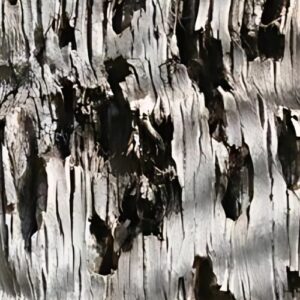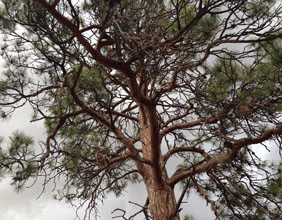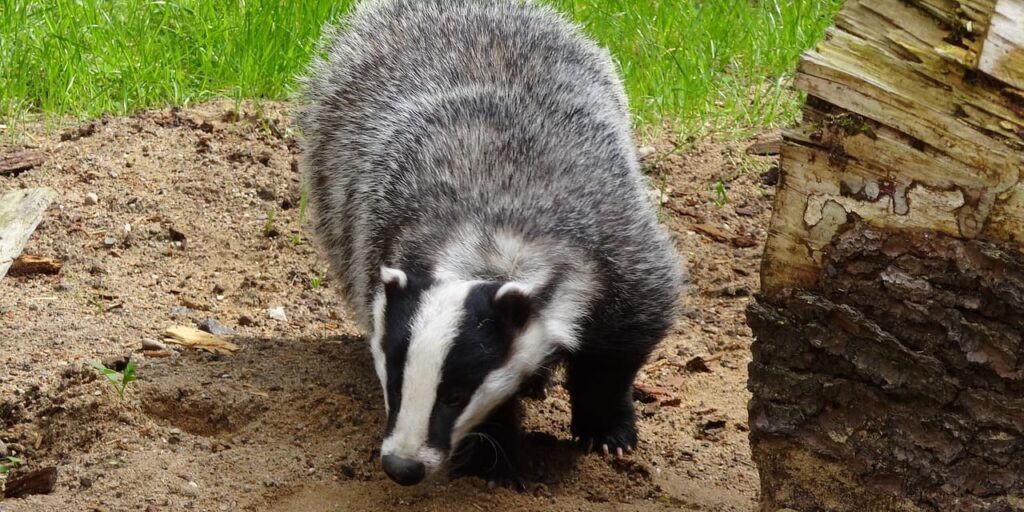
Have you recently noticed areas of disturbed soil around some of your trees? Or signs that something has been digging up the ground beneath certain trees? In some cases, it can look like an out-of-control rototiller ran through your yard!
Take a close look at which trees are being affected. If it’s mostly palo verde trees, then the damage was likely caused by a badger digging for palo verde borer grubs (the grubs are a tasty treat for badgers!).
In this article, we’ll cover some of the specifics of badgers in Arizona, why their digging is actually a good thing, and some of the relationships they have with other wildlife.
About Badgers
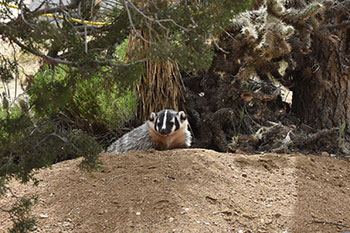
Badgers are found in most states and are nocturnal members of the weasel family. If you do catch a rare glimpse of one, it’s best to observe from a distance. While they are most likely to scurry away from you (or any other source of perceived danger), they will hiss, growl, or bite if they are cornered.
They don’t hunt their prey by running after them, but rather by digging up burrows. They are so well-suited for digging, in fact, that it’s been said that they can dig faster than a human using a shovel.
Badgers will eat squirrels, gophers, prairie dogs and other rodents, plus snakes, lizards, and insects. Given their diet, this is one animal you may actually want in your yard!
Badgers are solitary creatures so if you do by chance spot one, it will most likely be alone.
Mating season begins in late summer and continues through the fall, and new litters of badgers are born in early spring.
While badgers do not hibernate, they can stay in their dens for up to a month, usually during the times of year when prey is scarce.
Badgers in Arizona
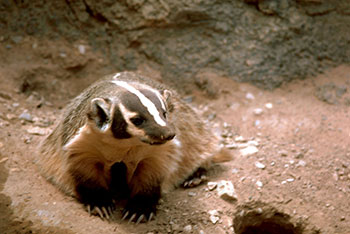
Since badgers are primarily active at night, you may not have even been aware that badgers live in our area. But they do!
Although badgers are found all over Arizona, not much is known about them (but they’re being studied). The Coalition for Sonoran Desert Protection has noticed that badgers tend to appear more during new moons than full moons (possibly because they can hide in the darkness from predators?). They’ve even caught some images of badgers on their wildlife cameras in Pima County.
Badgers found in Arizona are between 10 and 20 pounds when they are adults. They measure around 20 inches long, plus a 5-inch tail. Arizona badgers have silvery gray fur, with black feet and a black spot on each cheek. They also have a white stripe down their face that can sometimes continue along their back.
Badgers prefer to live in areas where they can dig in the dirt and find plenty of burrows for food. They have short, muscular legs and the front paws have longer claws, which is why badgers are so skilled at digging.
When are you most likely to spot a badger?
Badgers are nocturnal. If you’re out at night, look for their eyes – they shine green. They’re also sometimes spotted at dawn or dusk. If you spot a badger during the day, it’s most likely a young one. They tend not to wander far during daylight hours because it puts them at greater risk from several predators.
Badgers prefer to stay in their burrows or in areas that have groundcover that conceals them and protects them from the weather. This groundcover can include plants such as:
- creosote
- junipers
- gambel oak
- willows
- cottonwoods
- grasses
- sagebrushes
The unique relationship between badgers and coyotes
You may have seen a viral video a while back where a wildlife camera captured a coyote appearing to “play” with a badger, and then both of them journeyed through a tunnel together.
While instances of badgers and coyotes being “friends” is rare, they do sometimes hunt together.
Badgers hunt by digging into burrows, while coyotes chase prey down. By working together, they have a greater chance of catching something. For example, if an underground burrow has another exit, coyotes will chase down prey escaping from the badger. Alternatively, coyotes may drive rodents into their burrows, where the badger can easily dig down to catch the rodent.
You can see this mutually beneficial hunting method at work in this video taken at Yellowstone National Park. (Warning – The video shows some graphic images that may not be appropriate for everyone to view).
This hunting partnership does not mean that coyotes and badgers always get along. In fact, young badgers, called cubs, are a food source for coyotes. Older badgers have to watch out for mountain lions and bobcats, and young badgers are often eaten by large birds.
Other benefits of badgers
Badgers can have a positive influence on their environment. For example, their burrows can provide shelter for other forms of wildlife. And their digging has been shown to increase water infiltration (something we need in the desert) and has benefited soil development.
Badgers and Palo Verde Trees
Just as badgers and coyotes can help each other out by doing what comes naturally to them, badgers are now showing that they can help trees as well.
Their digging may cause a bit of a mess in your yard, but the pests that they’re digging up and eating would otherwise harm your trees. Though it may look unsightly, this is really nature’s form of pest control.
As we’ve previously written, palo verde beetles can do a lot of damage to your trees. Badgers and their digging skills can save you some time and money – and possibly your tree!
Issues Caused by Badgers
Occasionally, badgers can do more harm than good. Their digging can create tripping hazards for people and animals, and can damage gardens. Badgers have also been known to reach and eat poultry by tunneling beneath fences or floors. Interestingly, the tracks that badgers leave behind are similar to coyote tracks, so it can often be hard to distinguish which predator is to blame.
If you suspect that badgers might be more of a problem than a benefit on your property, you may want to install motion-sensing floodlights (keeping in mind our dark sky laws). As nocturnal creatures, badgers shy away from bright lights, and the sudden appearance of lights may scare them away.
Conclusion
In most cases, the benefits outweigh the issues and inconveniences that badgers might cause. They are a helpful and natural pest and rodent control and are very rarely seen. If you’re noticing that the ground near the roots of your trees has been disturbed, it may very well have been your neighborhood badger doing some quick pest control.
If you have any questions about this or any other tree or pest issue, give Titan Tree Care a call!
More Articles Like This

Titan Tree Care is a full-service tree care company located in Anthem, AZ and serving all of North Phoenix. We offer a wide range of services to meet your tree care needs, including tree and palm trimming, tree pruning, tree removal, stump grinding, and more. We also offer insect or disease treatments and fertilization services. We are dedicated to providing high-quality, safe, and effective tree care services to our customers and work hard to ensure that your trees are healthy and look their best.






